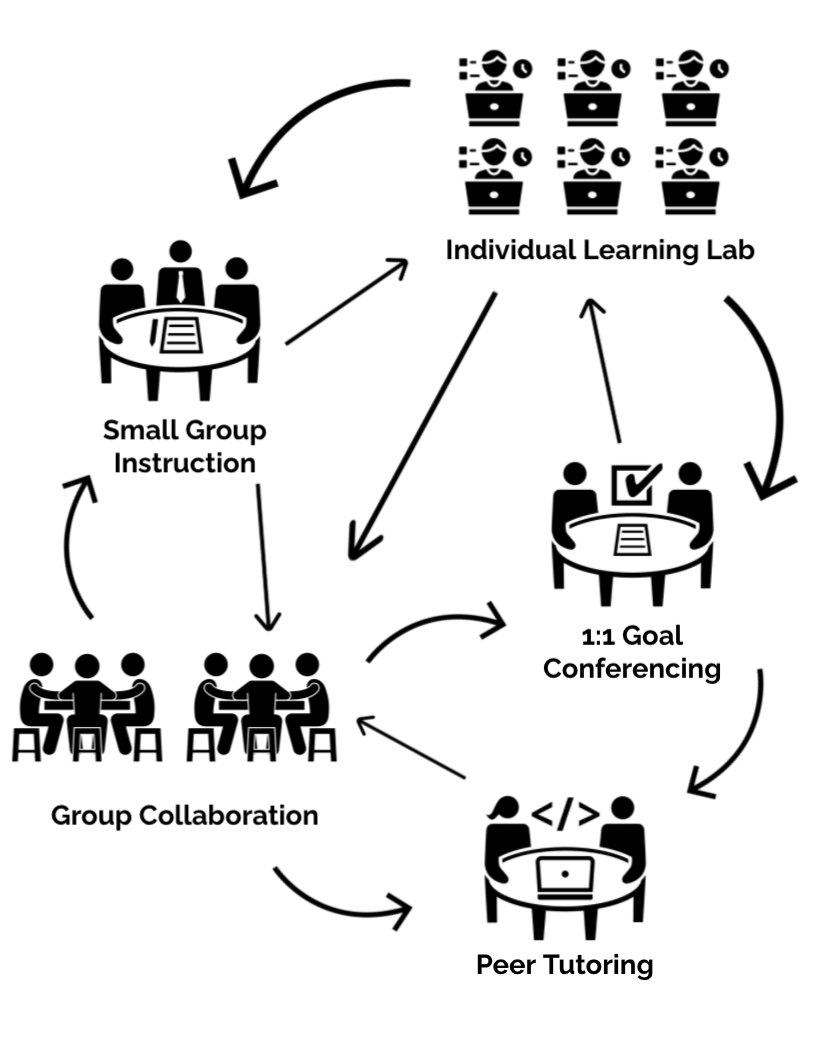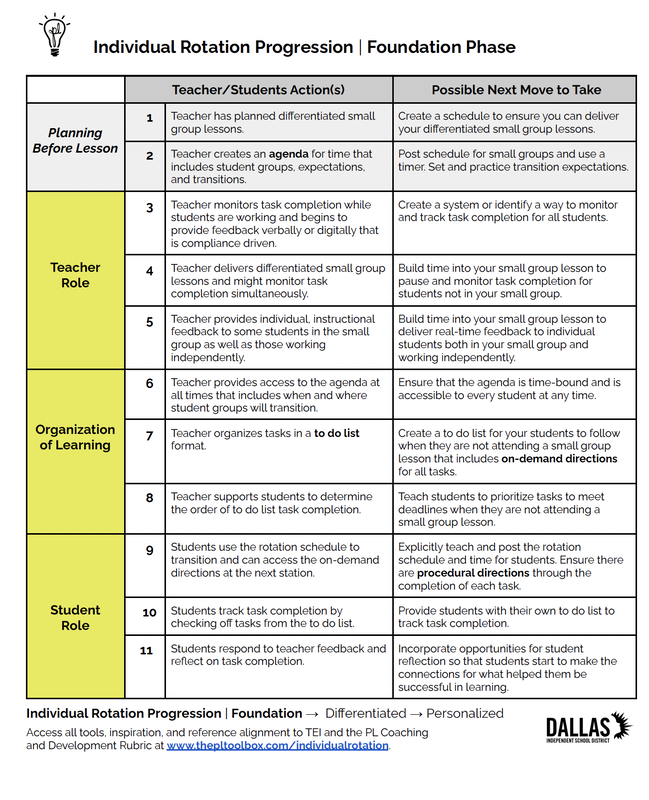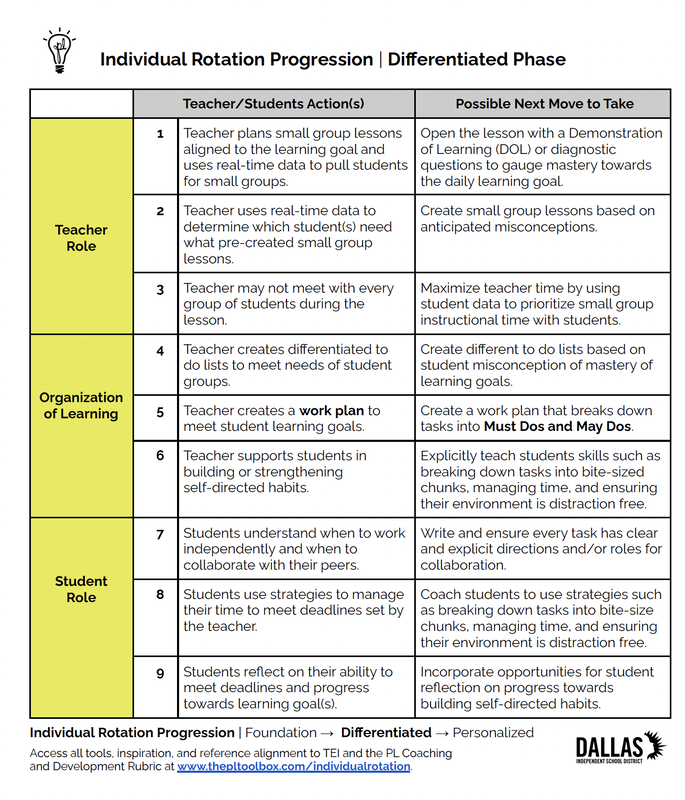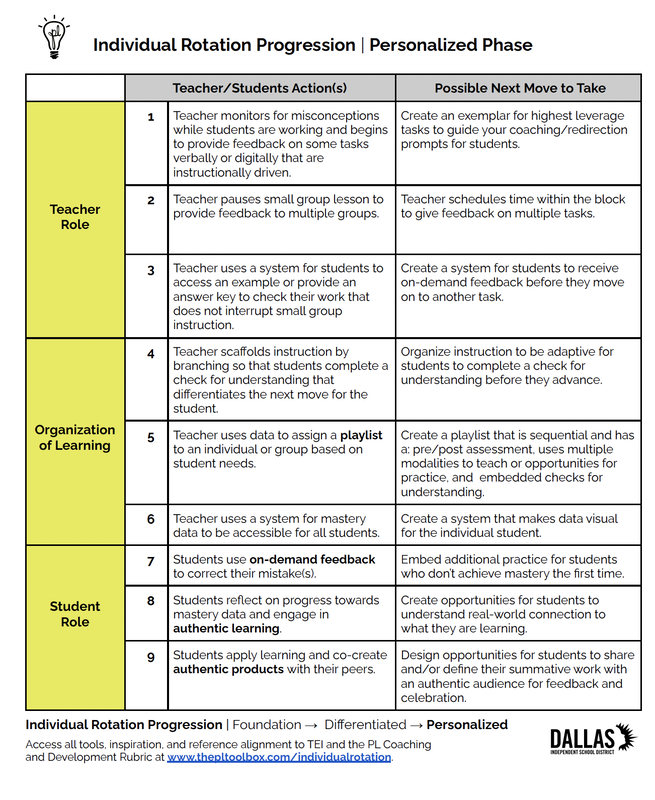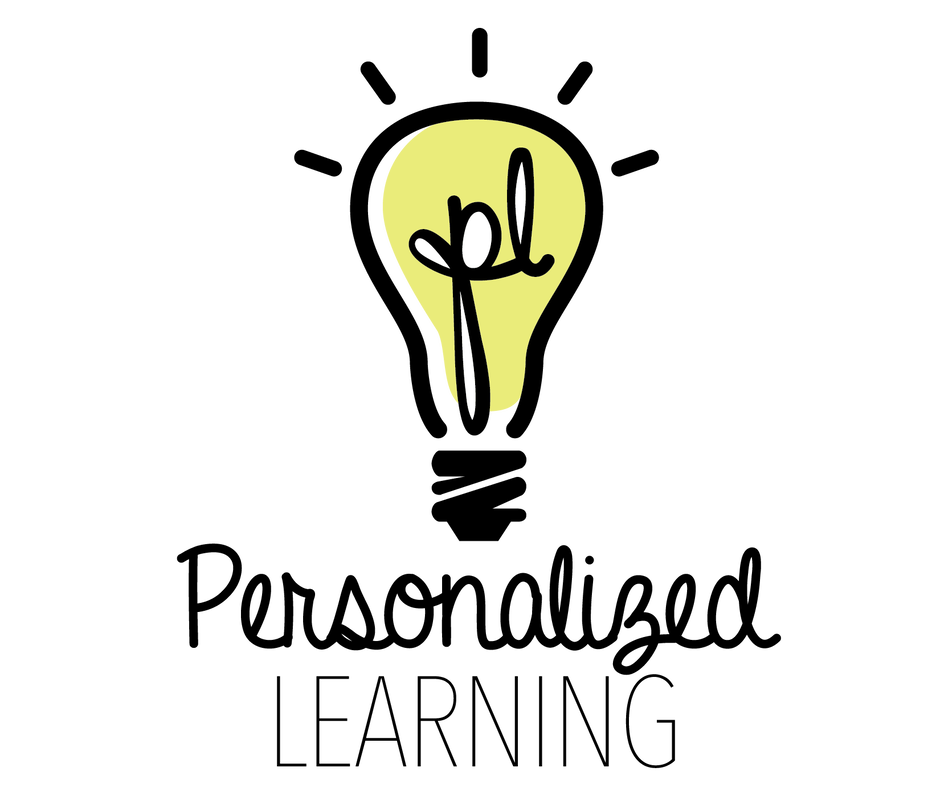The Individual Rotation Progression is a tool that identifies the necessary steps to take when implementing a Blended Individual Rotation Model.
|
Blended Individual Rotation Model
Learn more about the Blended Individual Rotation Model by visiting the Blended Learning Universe at www.blendedlearning.org. |
|
|
A progression is a pathway a learner might take to reach the end goal or learning target. This tool is carefully sequenced across three phases of implementation:
|
|
Identifies the sequence of teacher and student actions that must be mastered in order to establish the foundation and readiness for an effective individual rotation.
|
Identifies the sequence of teacher and student actions that enables differentiation in an effective indivdiual rotation.
|
Builds on the Foundation and Differentiated phases to identify the sequence of teacher and student actions that meet the need and interest of every learner.
|
Below you'll find articles, research, practitioner training, and campus or classroom examples from Dallas ISD leaders to suggest the next move you (or for those you coach) might take.
Foundation Phase
Identifies the sequence of teacher and student actions that must be mastered in order to establish the foundation and readiness for an effective individual rotation.
Identifies the sequence of teacher and student actions that must be mastered in order to establish the foundation and readiness for an effective individual rotation.
Planning Before Lesson
1. Teacher has planned differentiated small group lessons. Varied Learning Experiences + Differentiated Learning Objectives, Data Driven Instruction |
Next Move: Create a schedule to ensure you can deliver your differentiated small group lessons. |
|
2. Teacher creates and shares an agenda for time that includes student groups, expectations, and transitions. Routines + Procedures |
Next Move: Post schedule for small groups and use a timer. Set and practice transition expectations. |
|
Teacher Role
3. Teacher monitors task completion while students are working and begins to provide feedback verbally or digitally that is compliance driven. Student Feedback. Rapport with Students PBL: Critique & Revision |
Next Move: Create a system or identify a way to monitor and track task completion for all students. |
|
4. Teacher delivers differentiated small group lessons and might monitor task completion simultaneously. Varied Learning Experiences + Differentiated Learning Objectives |
Next Move: Build time into your small group lesson to pause and monitor task completion for students not in your small group. |
|
5. Teacher provides individual, instructional feedback to some students in the small group as well as those working independently. Student Feedback PBL: Critique & Revision |
Next Move: Build time into your small group lesson to deliver real-time feedback to individual students both in your small group and working independently. |
|
Organization of Learning
6. Teacher provides access to the agenda at all times that includes when and where student groups will transition. Routines + Procedures |
Next Moves: Ensure that the agenda is time-bound and is accessible to every student at any time. |
|
7. Teacher organizes tasks in a to-do list format. Routine and Procedures, Varied Learning Experiences |
Next Move: Create a to do list for your students to follow when they are not attending a small group lesson that includes on-demand directions for all tasks. |
|
8. Teacher supports students to determine the order of to do list task completion. Rapport with Students + Opportunities for Input |
Next Move: Teach students to prioritize tasks to meet deadlines when they are not attending a small group lesson. |
|
Student Role
9. Students use the rotation schedule to transition and can access the on-demand directions at the next station. Routines + Procedures |
Next Move: Explicitly teach and post the rotation schedule and time for students. Ensure there are procedural directions through the completion of each task. |
|
Next Move: Provide students with their own to do list to track task completion. |
|
11. Students track progress on software only using metrics of time or lessons completed. Data Driven Instruction |
Next Move: Incorporate opportunities for student reflection so that students start to make the connections for what helped them be successful in learning. |
|
Differentiated Phase
Identifies the sequence of teacher and student actions that enables differentiation in an effective individual rotation.
Identifies the sequence of teacher and student actions that enables differentiation in an effective individual rotation.
Teacher Role
1. Teacher plans small group lessons aligned to the learning goal and uses real-time data to pull students for small groups. Data Driven Instruction + Differentiated Learning Objectives |
Next Move: Open the lesson with a Demonstration of Learning (DOL) or diagnostic questions to gauge mastery towards the daily learning goal. |
|
2. Teacher uses real-time data to determine which student(s) need what pre-created small group lessons. Data Driven Instruction, Differentiated Learning Objectives, + Routines and Procedures |
Next Move: Create small group lessons based on anticipated misconceptions. |
|
3. Teacher may not meet with every group of students during the lesson. Differentiated Learning Objectives + Collaborative Grouping |
Next Move: Maximize teacher time by using student data to prioritize small group instructional time with students. |
|
Organization of Learning
4. Teacher creates differentiated to-do lists to meet needs of student groups. Differentiated Learning Objectives + Self-Direction |
Next Move: Create different to-do lists based on student misconception of mastery of learning goals. |
|
5. Teacher creates a work plan to meet student learning goals. Differentiated Learning Objectives, Self-Direction, + Opportunities for Input |
Next Move: Create a work plan that breaks down tasks into Must Dos and Mays Dos. |
|
6. Teacher supports students in building or strengthening self-directed habits. Rapport with Students + Growth Mindset |
Next Move: Explicitly teach students skills such as breaking down tasks into bite-sized chunks, managing time, and ensuring their environment is distraction free. |
|
Student Role
7. Students understand when to work independently and when to collaborate with their peers. Opportunities for Input + Access to Materials PBL: Student Voice & Choice |
Next Move: Write and ensure every task has clear and explicit directions and/or roles for collaboration. |
|
8. Students use strategies to manage their time to meet deadlines set by the teacher. Opportunities for Input + Growth Mindset |
Next Move: Coach students to use strategies such as breaking down tasks into bite-size chunks, managing time, and ensuring their environment is distraction free. |
|
9. Students reflect on their ability to meet deadlines and progress towards learning goal(s). Self-Direction, Opportunities for Input, + Growth Mindset PBL: Reflection |
Next Move: Incorporate opportunities for student reflection on progress towards building self-direct habits. |
|
Personalized Phase
Builds on the Foundation and Differentiated phases to identify the sequence of teacher and student actions that meet the need and interest of every learner.
Builds on the Foundation and Differentiated phases to identify the sequence of teacher and student actions that meet the need and interest of every learner.
Teacher Role
1. Teacher monitors misconceptions while students are working and begins to provide feedback on some tasks verbally or digitally that are instructionally driven. Data Driven Instruction + Student Feedback PBL: Critique & Revision |
Next Move: Create an exemplar for highest leverage tasks to guide your coaching/redirection prompts for students. |
|
2. Teacher pauses small group lesson to provide feedback to multiple groups. Student Feedback PBL: Critique & Revision |
Next Move: Teacher schedules time within the block to give feedback on multiple tasks. |
|
3. Teacher uses a system for students to access an example or provide an answer key to check their work that does not interrupt small group instruction. Student Feedback + Routines and Procedures |
Next Move: Create a system for students to receive on-demand feedback before they move on to another task. |
|
Organization of Learning
4. Teacher scaffolds instruction by branching so that students complete a check for understanding that differentiates the next move for the student. Personalized Learning Pathways + Student Feedback |
Next Move: Organize instruction to be adaptive for students to complete a check for understanding before they advance. |
|
5. Teacher uses data to assign a playlist to an individual or group based on student needs. Data Driven Instruction, Self- Direction, + Routines and Procedures |
Next Move: Create a playlist that is sequential and has a: pre/post assessment, uses multiple modalities to teach or opportunities for practice, and embedded checks for understanding. |
6. Teacher uses a system for mastery data to be accessible for all students. Data Driven Instruction, Personalized Learning Pathways, + Access to Materials |
Next Move: Create a system that makes data visual for the individual student. |
|
Student Role
7. Students use on-demand feedback to correct their mistakes(s). Student Feedback, Growth Mindset PBL: Critique & Revision |
Next Move: Embed additional practice for students who don’t achieve mastery the first time. |
|
8. Students reflect on progress towards mastery data and engage in authentic learning. Self- Direction + Advocacy Beyond Self PBL: Authenticity + Reflection |
Next Move: Create opportunities for students to understand real-world connection to what they are learning. |
|
9. Students apply learning and co-create authentic products with their peers. Peer Accountability, Collaborative Grouping PBL: Authenticity, Sustained Inquiry, Critique & Revision, Public Product, + Student Voice & Choice |
Next Move: Design opportunities for students to share and/or define their summative work with an authentic audience for feedback and celebration. |
|
| Individual Rotation Extended Progression 2.0 | |
| File Size: | 182 kb |
| File Type: | |
| Individual Rotation Progression | Foundation Phase 2.0 | |
| File Size: | 176 kb |
| File Type: | |
| Individual Rotation Progression | Differentiated Phase 2.0 | |
| File Size: | 168 kb |
| File Type: | |
| Individual Rotation Progression | Personalized Phase 2.0 | |
| File Size: | 169 kb |
| File Type: | |
